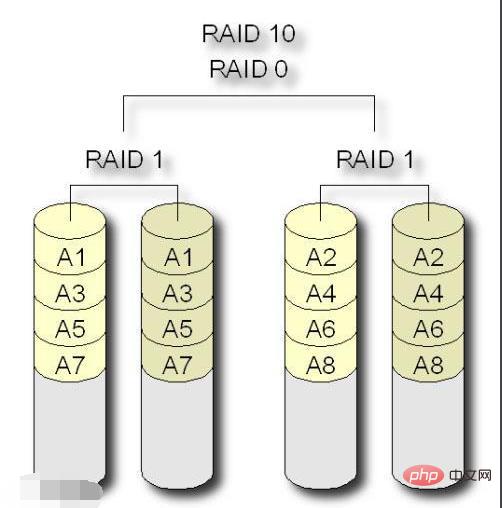raid10 requires "4 2*N" hard disks, where N is greater than or equal to 0; raid10 is a combination of Raid1 and Raid0. It uses parity to implement stripe set mirroring, so it inherits Raid0 is fast and Raid1 is safe; its advantage is that it has both the extraordinary speed of RAID0 and the high data reliability of RAID1, but the CPU usage is also higher and the disk utilization is relatively low.

#The operating environment of this tutorial: Windows 10 system, Dell G3 computer.
How many hard drives are needed for raid10?
Raid 10 is a combination of Raid 1 and Raid0. It uses parity to implement stripe set mirroring, so it inherits the speed of Raid0 and the security of Raid1. We know that RAID 1 here is a redundant backup array, while RAID 0 is responsible for reading and writing data to the array. In fact, the overview diagram is just a RAID 10 method. In more cases, two channels are branched from the main channel to perform Striping operation, that is, to split the data, and each branched channel is further divided into two channels to perform Mirroring operation. That is, mirroring each other.

RAID 1 0 is also called the RAID 10 standard. It is actually a combination of the RAID 1 and RAID 0 standards. It is continuously divided into bits or bytes. While reading/writing data to multiple disks in parallel, disk mirroring is performed for each disk for redundancy. Its advantage is that it has both the extraordinary speed of RAID 0 and the high data reliability of RAID 1, but the CPU usage is also higher and the disk utilization is relatively low. Due to the extremely high reading and writing efficiency of RAID 0 and the high data protection and recovery capabilities of RAID 1, RAID 10 has become a cost-effective level. Currently, almost all RAID control cards support this level. However, RAID 10's utilization of storage capacity is as low as RAID 1, only 50%. Therefore, RAID10 is a highly reliable and efficient disk structure. It is a strip structure plus a mirror structure, which can achieve both high speed and security. RAID 10 can provide better performance than RAID 5. The scalability of this new structure is not good, this solution is widely used, and it is relatively expensive to use this solution.
Pay attention to the difference between Raid 10 and Raid01:
RAID01 is also called RAID0 1. First perform strip storage (RAID0), and then Mirror (RAID1).
RAID10 is also called RAID1 0. It is mirrored first (RAID1) and then striped (RAID0).
Structure
The structure of Raid 10 is actually very simple. First create two independent Raid1s, and then combine these two independent Raid1s into one Raid0. When going to this logic When writing data in Raid, the data is written into two Raid1s in order. Disk 1 and disk 2 form a Raid1, and disk 3 and disk 4 form another Raid1; these two Raid1s form a new Raid0. For example, the data 1, 3, 5, and 7 written on hard disk 1 are data 1, 3, 5, and 7 written on hard disk 2. The data in hard disk 3 are 0, 2, 4, and 6. The data written in hard disk 4 are The data is 0, 2, 4, and 6, so the data is combined into Raid10 on these four hard disks and has the characteristics of both raid0 and raid1.
Although the Raid10 solution causes 50% disk waste, it provides 200% speed and data security against single disk damage, and when the disks damaged at the same time are not in the same Raid1, data security can be guaranteed sex. If a certain disk in the disk fails, the entire logical disk can still work normally.
When we need to restore a damaged disk in RAID 10, we only need to replace the new hard disk and perform data recovery according to the working principle of RAID 10. The system can still work normally during the data recovery process. The original data will be restored to the replaced hard drive simultaneously.
In general, RAID 10 uses RAID 0 as the execution array and RAID 1 as the data protection array. It has the same fault tolerance as RAID 1, with the system overhead and separate mirroring operations used for fault tolerance processing. Basically the same, with higher I/O bandwidth due to the use of RAID 0 as the execution level; it is a perfect solution for those who want to significantly improve performance over RAID 1. RAID 10 is suitable for database storage servers and other applications that require high performance and high fault tolerance but do not require large capacity.
Advantages and Disadvantages
RAID10 is also known as mirrored array striping. Like RAID0, data is extracted across disks; like RAID1, each disk has a mirror disk, so another way of saying RAID 10 is RAID 10. RAID10 provides 100% data redundancy and supports larger volume sizes, but the price is relatively high. For most applications that only require redundancy without considering price, RAID10 provides the best performance. With RAID10, you get better reliability because even if two physical drives fail, one in each array, the data is still protected. RAID10 requires 4 2*N disk drives (N >=0), and can only use half or less of the disk usage. For example, if four 250G hard disks use a RAID10 array, the actual capacity is 500G.
For more related knowledge, please visit the FAQ column!
The above is the detailed content of How many hard drives are needed for raid10?. For more information, please follow other related articles on the PHP Chinese website!